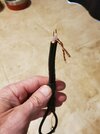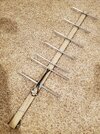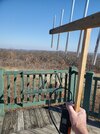Not sure why you want a 1:1 balun. The feed point of a split element driven on a yagi is not 50Ω. I also think that style balun uses common-mode current and messes with the antenna pattern. There are better options.
When you say you got real close to 50Ω with an SWR of 1.25, was that into the load resistor while adjusting the coax balun only, or with the balun connected to the antenna?
Coax for balun use is cut based on electrical length for the frequency. On the nano, you could connect the quarter wave section (set to CW, not sweep, at the center of desired band) and trim it until the trace stops a half revolution away on the other side of the smith chart. With the clipped end open (center not touching shield), the reading will be at the 0Ω side when clipped right for a quarter wavelength. With the 3/4 wave section connected, set it to center freq/3 and repeat. Then assemble the two together and test it into a load resistor. But again, that driven is not 50Ω, so why 1:1?
Why not go with a gamma match? It would let you keep the driven as one solid piece (more sturdy with staples) and provide a much better match. The usual starting point is with the gamma side of the driven element 2% shorter, the gamma rod half the diameter of the driven, 0.05λ long, spaced 0.007λ away, and with a series capacitance of about 7pF / meter of λ.
Ok, so these are baseline values commonly thrown around in HF discussions, but at 70cm, these values result in a really short gamma rod with a tiny spacing. This is where the gamma rod diameter can be made even smaller. What happens is the impedance ratio increases, which means you need more inductance to get up to the 50Ω constant conductance circle and the capacitance ends up being close to the same if the gamma side of the DE is not shortened. I've used 14awg copper wire to gamma match a 1/4" DE with a spacing of 1" at 1.25m, so with the nano, you can make a gamma rod out of just about anything that will hold up a chickadee cracking sunflowers.
With the nano (calibrated to the antenna's coax connector), start with no (or shorted) gamma capacitor so the gamma rod is connected directly to coax connector. Whatever size rod and spacing you choose, extend the rod/shorting bar to the point the nano reads 50Ω resistive, then whatever the reactance is, cancel it with series capacitance at the coax connector. Avoid dissimilar metals if possible.




